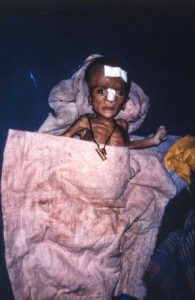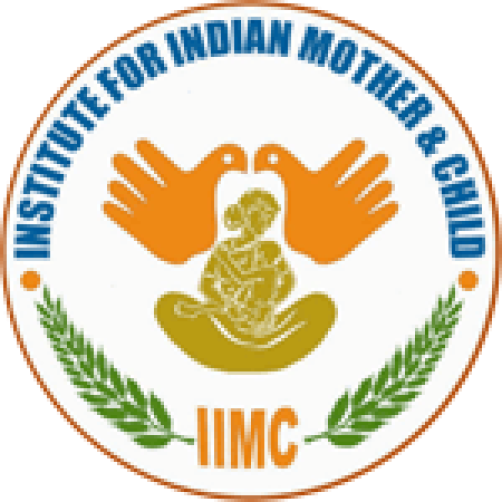A Foundation for Empowerment

Rediscovering hunger
Sometime in 1989, Dr. Brahmochary was ready to receive the poor mother and child in his humble health centre, which was in Sonarpur, then a remote village. The groundwork was satisfactory. The dilapidated building's room, in which he was now sitting, was ready, though it smelt bit musty, after all it had been a cowshed. The scrubs in the surrounding were cleared, he could now see the road running along the front ground. His physician friends in the city remained standby to whom he would refer severe cases, and from them he would also get the donation of medicines and money. He had the consent of the local leaders, mostly the male family-heads, that their female family members and children were allowed to come to the centre. He was content to think that he would be able to save resource and time of the sick mothers and children from going to the city for their treatment.
Dr. Brahmochary treats a child
The ordinary sari-clad mothers slowly walked into the centre leading their children by hand or carrying them on flank. Children were clingy to their mothers, crying or weeping even their mothers tried to hush them. Mothers looked skinny, tired, having sunken eyes, halting steps and feeble voice. Dr. Brahmochary’s hearty greetings made them comfortable, which made them to talk about their sickness freely and in detail. Checking and treating the mothers and children, he assumed their health complaints were the common, typical problem of a socially and economically deprived area, which he also had seen while he had worked in a deprived area in Africa. The mothers complained they felt always tired, without having enough strength to carry on their childcare and household work. They had no idea why they often became felt depressed, irritated, which made them unfair to deal with their family members and neighbours. Some mothers, especially the pregnant ones, were having swollen, heavy legs, causing pain and difficulty to walk. Many of the mothers were suffering from long lasting cuts, sores, burns, cold, fever and diarrhoea, and these problems made them to come to the centre more than once. The children more or less were having the same complaints, apart from their swollen belly, twiggy hands and legs, including dry, colourless hair. Dr. Brahmochary provided them with the medicines as appropriately as possible, but he understood it clearly that all these complaints were the symptoms of malnutrition, emerging from the hunger that perpetual existed in poor family.
Hunger Controls Poor People
West Bengal’s familiarity with hunger is not new. West Bengal, as a part of whole Bengal, experienced severe hunger many times in a form of famine while some were documented, many passed un-documented; historically the famines of 1770 and 1943 were the most severe, horrific and atrocious. Some ideas of long term effect of the famines could be found by reading some epic novels of Bengali writers of the time. Movies were also made by depicting the peril aftermaths, for example, Oshoni Shanket, Distance Thunder, of world renowned film director, Satyajit Ray. Hunger, however, not only visited in the past, but it also makes its way in the present days very much in the poor societies. According to a study of the National Sample Survey Organisation of the Government of India, conducted in the early 2000s, the rural household in West Bengal scored highest percentage among other neighbouring states is not getting enough food ‘every day in some months of the year’, quoted by D. Bandopadhyay. The rediscovery of the hunger by Dr. Brahmochary serving the poor rural mothers and children in his humble health centre was a wake-up call for us.
Hunger endures in society as an ‘invisible killer’. Hunger often accompanies disease, leading the poor to death or life-long mental and physical unfitness. It is a continuous, lifelong suffering, and the poor are so much accustomed to it that they can hardly realise how life could be without it; they take it as granted that it is bestowed by the god. You may try to understand this suffering having no food for whole day, doing a kind of fasting, or, if you are determined, for couple of days. Still your realisation is not the same as the poor people live with the perpetual hunger. The difference is that you know that after fasting you would get food, the food and drink of your choice, but the poor have no such option, their hope of such meal is a mere bleak, and this void situation takes the poor to early death. Hunger can only be perceived by the hungry who often misses food.
Hunger ushers deadly malnutrition:

Severe malnutrition Dr. Brahmochary had no mistake to understand that hunger lives as malnutrition among the mother and child. Perpetual hunger plants malnutrition in body, by diminishing its resistance, and once body resistance is gone, illness nestles in the body. Then the illness attacks the feeble malnutrition, and when malnutrition gives in, the total damage of the body takes place bringing complete death of a poor body. In medical science most commonly known malnutrition is Protein Energy Malnutrition (PEM). It can be discovered when a poor family continuously lacks protein as well as calories in their inadequate food of low quantity and quality, which is not uncommon in the West Bengal's rural areas. The modern medical science says that when a poor man lacks calories, his body consumes existing protein to make body-fuel, and thus calories fail to rebuild necessary tissues to build up healthy body. There are two types of PEM: Kwashiorkor and Marasmus. Kwashiorkor creates an invisibly acute situation in a body, which we normally fail to notice looking at the sufferer. It basically damages the tissue inside body and covers it with water. We may see a child in his mother's lap with round face and swollen cheeks, unusually quiet, without any zest. In reality, the Kwashiorkor has made him miserable, withdrawn and inactive. On the other hand, Marasmus is sadly visible as it makes the victim too thin, pushing him to go down to 40 per cent less than normal weight, and his situation often attracts the attention of media. Poor diet for a long period stops his normal growth, and the body consumes all of his tissues. A child of Marasmus looks like shrunken mature man with broad head, thin hair, sunken eyes, loose fat-less skin, and mostly he is unable to move on his own while certain death looms behind him. Not only in children, Dr. Brahmochary also found PEM in women. PEM nestles in women as anaemia, lacking sufficient red cells in blood, making them lethargic, fatigue, indifference, eliminating mental and physical capacities. He was more concerned that the presence of PEM in pregnant mother. The reason is that PEM affected mother carries PEM affected foetus that brings a malnourished, unhealthy child in the ever challenging world.
Malnutrition brings human incapacity
Joaquin Cravioto (1922–1998), a renowned nutritionist, making a groundbreaking research on Mexican children, showed that a PEM affected child at his age 3 became nearly a year behind among his age-group in picking language development. Malnourished child lacks conception of the things,–fundamental skills for the abilities underlying the learning of reading and writing–which, in fact, are the keys to competitive achievement in education and future career. He is more withdrawn, isolated and deprived of mental and physical stimulation than the same healthy age-group. He spends most of the time in coping with different illnesses as he is susceptible to infection. If it is not so, then his mind is preoccupied with the anxiousness to get food that takes away his concentration from the study. Ignorant parents would mark him as a child of having ‘horse manure’ in his head, unworthy for education, and this assessment expedites his dropping out of the school, and plenty of such examples are available in the collection of IIMC’s education department.
Incapcity creates poverty-trap
Malnourished, hungry people chronically fail to earn. The hungry people, equally mother and father, are less productive. When hungry mother and father toil at home and in outdoor, their productivity is far less than the healthy ones. They are less likely to be hired to work in any household, field or factory. Mother would not be hired in any rich household lest she might be stealing food, eating more or unable to cope with heavy demand. Father’s wage earning work would not come easily. His feeble body would be unable to draw attention of any land and factory owners. In the field, he would not be able to work energetically to do head loading of crops or hays. In the factory, he would be prone to low output, unable to keep pace with machinery and much prone to accidents. Overall, all the malnourished, hungry people need frequent rest in the middle of their work; hiring them for work is a loss for the employer. This degraded position pushes them towards low-paid, casual employment, or they stay unemployed for indefinite period of time. Consequently, while malnourishment remains deep-rooted in the body, they can afford to buy less food, consume inadequate food than required daily meal, and they gradually caught in the trap of vicious poverty cycle, or undeserved early death.
Any Hope?

Simple nutritious food Dr. Brahmochary thought it was imperative first to strike the deadly interplay of hunger and malnutrition among poor mothers and children. He could foresee that without dealing with this chronic problem it would be difficult for them to change the poverty-laden societies. At the nascent stage of IIMC, he understood that dealing with malnutrition and hunger should be a recurrent activity as the prevailing socio-economic situation unable to assure the poor people with adequate healthy food. Presently, IIMC strongly advocates for nutritious food for poor rural mothers and children. Dr. Brahmochary has set an example of making a popular nutritious food in combination of locally available grains, which is cheap in price, easy to buy for poor family. To deal with the malnutrition at three stages, they are named as ND-S, ND-1 and ND-III, and the formula for the combination is available at IIMC. Besides, there is an arrangement of cooking and feeding this nutritious food for the ill mothers and children who are admitted to IIMC hospitals, and the message about this food goes to IIMC's working areas along with health education campaign. Once the mother and child gain their health, IIMC encourages them to adopt the challenge for building healthy life through education and income generation. According to Dr. Brahmochary, healthy mother and child are the strong pioneers for achieving empowerment.
Posted by – Abu B. Siddique
Email – a.siddique2012@btinternet.com




